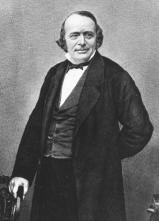Agassiz, Louis
Swiss-American Zoologist and Geologist
1807–1873
Jean Louis Rodolphe Agassiz has been called the "Father of Glaciology" and the "First Naturalist." One of the greatest contributors to the science of water, he discovered evidence of a time when the frozen state of water changed Earth's landscape: the Ice Age.
Born in Switzerland, Agassiz developed his love of nature from exploring the wilderness as a child. Receiving doctorate degrees in medicine and natural history at the University of Munich in Germany, he first distinguished

Fellow scientist Jean de Charpentier introduced Agassiz to the concept of glaciation on a larger scale. In that time, scientists thought that either the biblical flood or icebergs caused geological features such as misplaced boulders and grooved, polished rock. However, through the careful observational methods for which he was known, Agassiz discovered that they were indeed products of glacial movement. Because these features were found throughout Europe in areas where there were no present glaciers, Agassiz deduced that at one time global climatic changes produced giant sheets of ice that covered the Northern Hemisphere on a continental scale.
In 1840, Agassiz published his findings as "Etudes sur les Glaciers." Although many scholars at first opposed his ideas, the Ice Age theory was soon accepted around the world. Agassiz continued his teaching and research in the United States, where he became a professor of natural history at Harvard University and founded the Museum of Comparative Zoology, which is still part of the university today. Agassiz also helped create both the National Academy of Sciences and Cornell University, dedicating the rest of his life to expanding knowledge of, and promoting enthusiasm for, natural history.
Amy B. Parmenter
Bibliography
Gordon, John E. "Early Development of the Glacial Theory: Louis Agassiz and theScottish Connection." Geology Today 11, no. 2 (1995):64–68.
Lurie, Edward. Louis Agassiz: A Life in Science. Chicago, IL: The University of ChicagoPress, 1960.
Comment about this article, ask questions, or add new information about this topic: